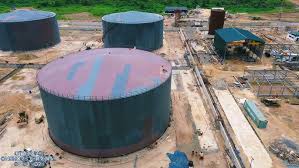Shell has lifted the first crude oil cargo from Nigeria’s new Otakikpo onshore terminal, officially marking the start of operations at the $400 million facility developed by Green Energy International Limited. The loading took place aboard the Aframax tanker Lipari, and it signals a major milestone in Nigeria’s oil export strategy, especially for marginal field operators.
The Otakikpo terminal is located in the Oil Mining Lease (OML) 11 block, southeast of Port Harcourt, Rivers State. The terminal is designed with a maximum export capacity of 360,000 barrels per day (bpd). Crude oil is transported through a 23-kilometre, 20-inch pipeline to a single point mooring system in the Atlantic Ocean, where tankers including Aframax and Suezmax vessels can dock and load, thanks to a draught of 21 metres.
Before the terminal was built, Green Energy had relied on a more expensive method involving barges to evacuate its production. That system reportedly cost around $120,000 per day. According to the company, the new terminal will reduce operating expenses by cutting down on transport costs and improving storage efficiency. This move is expected to lower crude production costs by as much as 40 per cent.
Kayode Adegbulugbe, Managing Director of the Otakikpo Oil Terminal, said the facility is a local solution that could reduce Nigeria’s dependence on costly offshore floating stations. “The government needs to realise that instead of spending on multiple float stations, this facility offers a home-grown alternative. When oil is stored in tanks, it lowers the cost of production per barrel significantly,” he said.
He also noted that operational expenses drop when crude is stored and handled efficiently onshore. “This facility will ensure that the costs will drop by at least 40 per cent,” he added.
Previously, Green Energy exported its Otakikpo light sweet crude through the Ima Floating Storage Unit (FSU), which is managed by Amni International Petroleum. The new onshore terminal is expected to unlock previously stranded crude output from more than 40 marginal fields in the surrounding region. Green Energy estimates these fields have a combined production capacity of 200,000 bpd and total reserves of around 3 billion barrels of oil equivalent.
The Otakikpo terminal is not just for Green Energy’s use. It is designed to receive up to 250,000 bpd from third-party producers as well. This includes supply via a 6-inch, 6-kilometre offshore pipeline that can connect nearby fields to the terminal. Green Energy also plans to build a gathering system to support crude intake from other producers in the area.
At present, the terminal has a crude storage capacity of 750,000 barrels. However, the company says it is ready to increase this capacity to 3 million barrels if the market demands it. During a recent meeting with the Independent Petroleum Producers Group (IPPG), Green Energy revealed it could expand its tank storage within nine months. Currently, utilisation at the terminal is still below 12 per cent.
The facility began injecting crude on March 30, 2025, with Green Energy’s April production averaging just 5,000 bpd. However, the company has obtained regulatory approval from the Nigerian Upstream Petroleum Regulatory Commission (NUPRC) to increase output to 30,000 bpd under an updated field development plan.
This development comes at a time when Nigeria is seeking to boost its crude oil exports, reduce operating costs, and support the activities of local producers, especially those operating marginal fields. By providing a more efficient and cost-effective export route, the Otakikpo terminal is expected to contribute to Nigeria’s broader efforts to increase production and improve earnings from the oil sector.
